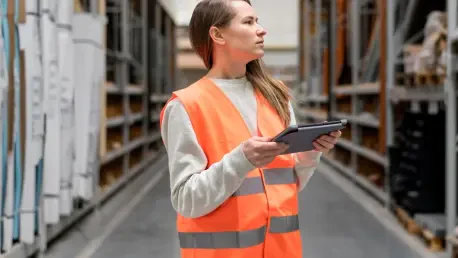Setting the Stage for Logistics Transformation
Imagine a global supply chain where a single delayed shipment in one corner of the world ripples across continents, costing millions in lost revenue and frustrated customers, a scenario that is not a distant possibility but a daily reality for many logistics providers grappling with fragmented systems and outdated processes. The complexity of modern trade, compounded by volatile markets and unpredictable disruptions, demands a solution that can unify disparate elements into a seamless operation. Enter integrated logistics platforms, a technological innovation poised to revolutionize how goods move across borders and industries. This review dives into the capabilities, performance, and transformative potential of these platforms, shedding light on their role in addressing the inefficiencies that plague traditional logistics.
Core Features Driving Efficiency
Real-Time Data Integration for Unmatched Visibility
At the heart of integrated logistics platforms lies the ability to provide real-time data integration, a feature that transforms fragmented supply chains into cohesive networks. This technology enables stakeholders—shippers, carriers, and customs officials—to access live updates on shipment status, location, and estimated delivery times. Such visibility eliminates blind spots, allowing for swift decision-making when delays or disruptions occur, and significantly reduces the risk of costly errors.
Beyond visibility, real-time data integration fosters collaboration by connecting previously siloed systems into a unified digital ecosystem. Platforms aggregate information from multiple sources, such as warehouse management systems and transportation tracking tools, to create a single source of truth. This convergence minimizes communication delays and ensures that all parties operate with the same, up-to-date information, enhancing overall supply chain responsiveness.
AI and Automation as Game-Changers
Another cornerstone of these platforms is the incorporation of artificial intelligence (AI) and automation, which elevate operational efficiency to new heights. AI-driven predictive analytics can forecast potential bottlenecks or delays by analyzing historical data and current market trends, enabling proactive measures before issues escalate. This capability shifts logistics from a reactive to a strategic approach, saving time and resources.
Automation, meanwhile, tackles repetitive tasks such as data entry, invoice processing, and route planning, reducing human error and freeing professionals to focus on high-value activities. For instance, automated systems can instantly reroute shipments based on real-time traffic or weather data, ensuring optimal delivery paths. Together, AI and automation create a streamlined workflow that not only boosts productivity but also enhances service reliability for end customers.
Performance in Real-World Scenarios
Integrated logistics platforms have proven their worth across diverse industries, from manufacturing to e-commerce, by solving complex logistical challenges. In retail, for example, these platforms enable pre-scheduled drayage based on live shipment updates, minimizing storage fees and ensuring timely store replenishments. This level of precision directly translates to improved inventory management and customer satisfaction.
In the manufacturing sector, the technology supports just-in-time delivery models by providing end-to-end visibility and AI-driven insights. Manufacturers can adjust production schedules dynamically based on shipment statuses, avoiding overstock or production halts. These use cases highlight how the platforms optimize resource allocation and reduce operational costs, delivering measurable value in high-stakes environments.
A notable trend in performance is the growing reliance on digital tools for resilience against disruptions. With global trade facing constant volatility, platforms that offer instant customs clearance alerts or contingency planning through AI rerouting have become indispensable. Their ability to adapt to changing conditions ensures continuity, positioning them as critical assets for businesses aiming to maintain competitive edges.
Industry Trends and Innovations
The logistics sector is witnessing a rapid shift toward end-to-end supply chain orchestration, a trend amplified by integrated platforms. Recent advancements include the seamless integration of Internet of Things (IoT) devices for real-time tracking at a granular level, enhancing data accuracy. This development, coupled with cloud-based solutions, allows for scalable and accessible logistics management across global operations.
Industry reports, such as the latest MHI Annual Industry Report, emphasize the urgent need for connectivity in today’s trade landscape. Businesses are increasingly adopting platforms that support multi-party collaboration and data sharing to navigate market shifts and regulatory changes. This move toward digital unification reflects a broader recognition that fragmented systems are no longer viable in a world demanding instant, reliable services.
Looking ahead, innovations in machine learning algorithms promise even greater precision in demand forecasting and risk assessment. As platforms evolve, their ability to integrate emerging technologies like blockchain for secure data transactions will likely redefine trust and transparency in logistics. These trends underscore the dynamic nature of the field and the continuous push for more robust, adaptable solutions.
Challenges Hindering Wider Adoption
Despite their potential, integrated logistics platforms face significant hurdles that limit widespread implementation. System interoperability remains a technical challenge, as many businesses operate on legacy systems that resist integration with modern platforms. Bridging this gap requires substantial investment and expertise, often deterring smaller players from making the transition.
Regulatory barriers also pose obstacles, with varying data privacy laws and compliance requirements across regions complicating platform deployment. Ensuring adherence to these standards while maintaining operational efficiency is a delicate balance that developers and adopters must navigate. Additionally, concerns over data security persist, as the centralized nature of these platforms can make them targets for cyber threats if not adequately protected.
Market resistance adds another layer of difficulty, as some stakeholders remain skeptical about the cost-benefit ratio of adopting new technology. Overcoming this inertia involves not only demonstrating tangible returns but also fostering industry-wide standards for integration. Efforts to address these challenges are underway, with initiatives focusing on standardized protocols and enhanced cybersecurity measures to build trust and facilitate broader uptake.
Future Trajectory and Potential
The future of integrated logistics platforms appears promising, with potential breakthroughs on the horizon that could further transform the industry. Enhanced AI capabilities, for instance, are expected to refine predictive models, offering even more accurate insights into supply chain dynamics over the next few years, from 2025 to 2027. Such advancements could redefine how businesses anticipate and respond to market demands.
Broader adoption of IoT devices is another area of growth, as these tools enable highly detailed tracking and monitoring, feeding richer data into platforms for analysis. This synergy could unlock new levels of operational precision, particularly in last-mile delivery, where efficiency directly impacts customer experience. The long-term impact may well be a fully connected, autonomous logistics ecosystem that minimizes human intervention.
Moreover, as sustainability becomes a priority, platforms are likely to incorporate features for optimizing carbon footprints through efficient routing and load planning. This alignment with environmental goals could position them as not just operational tools but also as drivers of corporate responsibility. The trajectory suggests a future where logistics is not only faster and smarter but also more aligned with global priorities.
Reflecting on the Impact
Looking back, this exploration of integrated logistics platforms revealed their profound capacity to address long-standing inefficiencies in supply chain management. Their ability to integrate real-time data, leverage AI, and automate processes stood out as pivotal in enhancing visibility and operational agility. Each feature and application reviewed demonstrated tangible benefits, from cost savings to improved customer trust, that reshaped industry standards.
As a next step, businesses are encouraged to prioritize pilot programs to test platform integration within their specific contexts, ensuring compatibility and measuring impact before full-scale adoption. Collaboration with technology providers to customize solutions and address interoperability issues emerged as a practical approach to overcoming initial barriers. Additionally, investing in training for staff to adapt to digital tools proved essential for maximizing returns on this technology.
Beyond immediate actions, consideration of long-term partnerships with platform developers to stay ahead of innovations like IoT and blockchain integration offers a strategic path forward. Advocating for industry standards through trade associations also surfaced as a way to ease regulatory and market challenges. These steps, taken collectively, pave the way for a more connected and resilient logistics landscape in the years that follow.









